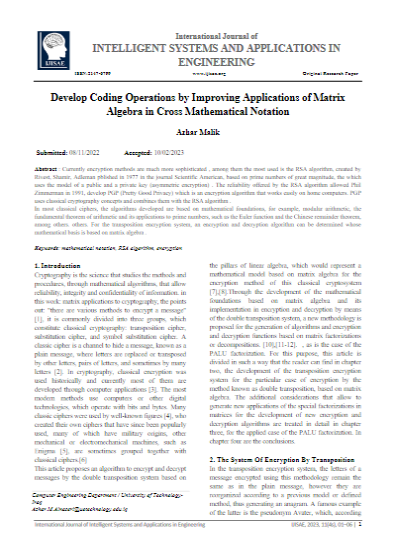Develop Coding Operations by Improving Applications of Matrix Algebra in Cross Mathematical Notation
Keywords:
mathematical notation, RSA algorithm, encryptionAbstract
Currently encryption methods are much more sophisticated , among them the most used is the RSA algorithm, created by Rivest, Shamir, Adleman pblished in 1977 in the journal Scientific American, based on prime numbers of great magnitude, the which uses the model of a public and a private key (asymmetric encryption) . The reliability offered by the RSA algorithm allowed Phil Zimmerman in 1991, develop PGP (Pretty Good Privacy) which is an encryption algorithm that works easily on home computers. PGP uses classical cryptography concepts and combines them with the RSA algorithm .
In most classical ciphers, the algorithms developed are based on mathematical foundations, for example, modular arithmetic, the fundamental theorem of arithmetic and its applications to prime numbers, such as the Euler function and the Chinese remainder theorem, among others. others. For the transposition encryption system, an encryption and decryption algorithm can be determined whose mathematical basis is based on matrix algebra .
Downloads
References
B. Stroustrup, OOPS Messenger, 1995, an addendum to the OOPSLA ’95 Proceedings.
J. R. Cary, S. G. Shasharina, J. C. Cummings, J. V. W. Reynders, and P. J. Hinker, Comput. Phys. Commun. ~submitted!; available at http:// jove.colorado.edu/˜ cary/CompCPP–F90SciOOP.html.
Y. Dubois-Pe`lerin and Th. Zimmermann, Comput. Methods Appl. Mech. Eng. 108, 165 ~1993!.
J-L. Liu, I.-J. Lin, M.-Z. Shih, R.-C. Chen, and M.-C. Hseih, Appl. Numer. Math. 21, 439 ~1996!.
Th. Zimmermann, Y. Dubois-Pe`lerin, and P. Bomme, Comput. Methods Appl. Mech. Eng. 98, 291 ~1992!.
L. Machiels and M. O. Deville, ACM Trans. Math. Softw. 23, 32 ~1997!.
Th. Zimmermann and D. Eyheramendy, Comput. Methods Appl. Mech. Eng. 132, 259 ~1996!. 14. D. Eyheramendy and Th. Zim
P. Moyer, Are we having fun yet? How teachers use manipulatives to teach mathematics, Educ. Stud. Math. 47 (2) (2001) 175–197, http://dx.doi.org/ 10.1023/A:1014596316942.
P. Moyer, G. Salkind, J. Bolyard, Virtual manipulatives used by K-8 teachers for mathematics instruction: The influence of mathematical, cognitive, and pedagogical fidelity, Contemp. Issues Technol. Teach. Educ. 8 (3) (2008) 202–218.
J.L. Cross, B. Brewer, E. Hamner, L. Zito, S. Speer, M. Tasota, Pilot results of a digital manipulative for elementary mathematics, in: AERA Annual Meeting, San Francisco, CA, 2020, URL http://tinyurl.com/sxgvcuy Conference Cancelled.
S. Suh, M. Lee, E. Law, How do we design for concreteness fading? Survey, general framework, and design dimensions, in: Proceedings of the Interaction Design and Children Conference, in: IDC ’20, Association for Computing Machinery, New York, NY, USA, ISBN: 9781450379816, 2020, pp. 581–588, http://dx.doi.org/10.1145/3392063.3394413.
Mirghafoori S H, Sayyadi Toranlu H, Dehghani Ashkezari J. Provision of a Model to Spread the Use of Information Technology in Serving. sjis 2020; 2 (1) :1-6

Downloads
Published
How to Cite
Issue
Section
License
Copyright (c) 2023 Azhar Malik

This work is licensed under a Creative Commons Attribution-ShareAlike 4.0 International License.
All papers should be submitted electronically. All submitted manuscripts must be original work that is not under submission at another journal or under consideration for publication in another form, such as a monograph or chapter of a book. Authors of submitted papers are obligated not to submit their paper for publication elsewhere until an editorial decision is rendered on their submission. Further, authors of accepted papers are prohibited from publishing the results in other publications that appear before the paper is published in the Journal unless they receive approval for doing so from the Editor-In-Chief.
IJISAE open access articles are licensed under a Creative Commons Attribution-ShareAlike 4.0 International License. This license lets the audience to give appropriate credit, provide a link to the license, and indicate if changes were made and if they remix, transform, or build upon the material, they must distribute contributions under the same license as the original.





